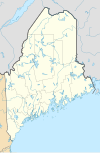
Back حديقة أكاديا الوطنية Arabic Taman Nasional Acadia BAN Акадия (национален парк) Bulgarian Parc Nacional d'Acàdia Catalan Acadia National Park CEB Národní park Acadia Czech Acadia National Park Danish Acadia-Nationalpark German Parque nacional Acadia Spanish Acadia rahvuspark Estonian
| Acadia National Park | |
|---|---|
IUCN category V (protected landscape/seascape) | |
 | |
| Location | Hancock & Knox counties, Maine, United States |
| Nearest city | Bar Harbor |
| Coordinates | 44°21′N 68°13′W / 44.350°N 68.217°W |
| Area | 49,075 acres (198.60 km2) 861.46 acres (348.62 ha; 3.4862 km2) private (in 2017)[1] |
| Established | July 8, 1916 (as Sieur de Monts National Monument) February 26, 1919 (as Lafayette National Park) January 19, 1929 (as Acadia National Park)[2] |
| Visitors | 2,669,034 (in 2020)[3] |
| Governing body | National Park Service |
| Website | nps |
Acadia National Park is a national park of the United States located along the mid-section of the Maine coast, southwest of Bar Harbor. The park includes about half of Mount Desert Island, part of the Isle au Haut, the tip of the Schoodic Peninsula, and portions of sixteen smaller outlying islands.
The park contains the tallest mountain on the Atlantic Coast of the United States (Cadillac Mountain), exposed granite domes, glacial erratics, U-shaped valleys, and cobble beaches. Its mountains, lakes, streams, wetlands, forests, meadows, and coastlines contribute to a diversity of plants and animals. Woven into this landscape is a historic carriage road system financed by John D. Rockefeller Jr.[4] In total, it encompasses 49,075 acres (19,860 ha; 76.680 sq mi; 198.60 km2) as of 2017[update].
Acadia has a rich human history, dating back more than 10,000 years ago with the Wabanaki people. The 17th century brought fur traders and other European explorers, while the 19th century saw an influx of summer visitors, then wealthy families. Many conservation-minded citizens, among them George B. Dorr (the "Father of Acadia National Park"), worked to establish this first U.S. national park east of the Mississippi River and the only one in the Northeastern United States. Acadia was initially designated Sieur de Monts National Monument by proclamation of President Woodrow Wilson in 1916, then renamed and redesignated Lafayette National Park in 1919. The park was renamed Acadia National Park in 1929.
Recreational activities from spring through autumn include car and bus touring along the Park Loop Road; hiking, bicycling, and horseback riding on carriage roads (motor vehicles are prohibited); fishing; rock climbing; kayaking and canoeing on lakes and ponds; swimming at Sand Beach and Echo Lake; sea kayaking and guided boat tours on the ocean; and various ranger-led programs. Winter activities include cross-country skiing, snowshoeing, snowmobiling, and ice fishing. Two campgrounds are located on Mount Desert Island, another campground is on the Schoodic Peninsula, and five lean-to sites are on Isle au Haut. The main visitor center is at Hulls Cove, northwest of Bar Harbor. Park visitation has been steadily increasing in Acadia over the past decade, with 2021 seeing a record count of 4.07 million visitors.[5] In 2023 the park saw 3,879,890 recreational visitors.[6]
- ^ "National Reports - Park Acreage Reports (1997 – Last Calendar/Fiscal Year)". irma.nps.gov. National Park Service. Retrieved December 7, 2018.
Select By Park; Calendar Year; select year; View PDF Report - see Gross Area Acres in the rightmost column of the report
- ^ Cite error: The named reference
nps_statswas invoked but never defined (see the help page). - ^ "NPS Annual Recreation Visits Report". National Park Service. Retrieved May 26, 2020.
- ^ Cite error: The named reference
foundationdocwas invoked but never defined (see the help page). - ^ Clement, Stephanie (May 4, 2022). "What Does Four Million Visits Mean To Acadia?". National Parks Traveler. Retrieved July 24, 2022.
- ^ "Top 10 most visited national parks". Travel. March 27, 2024. Retrieved March 27, 2024.



